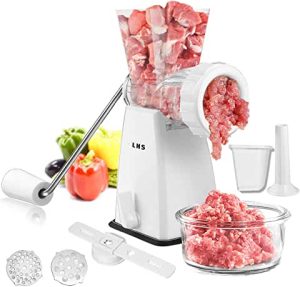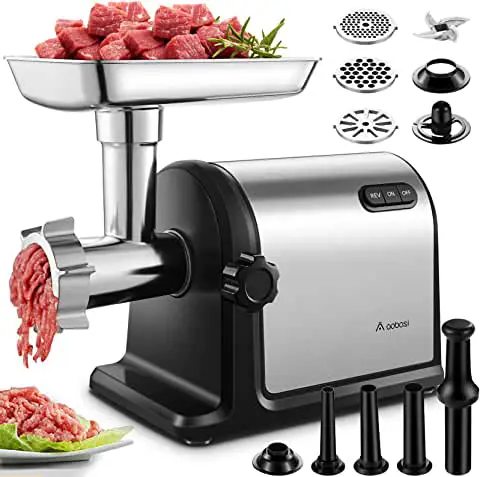Many Eastern cuisines, particularly those of Arabic origin, require minced meat. Meat grinders are also referred to as meat mincers. This has prompted many people to invest in a meat mincer. This article has been put together to help you choose between an electric and a manual mincer.
It’s safe to say that mincing meat isn’t just something done in Arabic kitchens. Most people use it to make hamburgers, hotdogs, and sausages, just to name a few Western favorites. The Arab diet is rich in foods that need minced meat. Hence, many families buy their own meat mincers.
Customers can choose between purchasing pre-minced meat or the machine necessary to create minced meat in the comfort of their own homes.
No products found.
Finding what you’re looking for is difficult because the market is flooded with countless designs, types, and brands. Keep in mind that some still favor the manual meat mincer.
Since it uses a knife to chop the meat, a manual model is ideal for those who don’t often mince meat or who don’t require finely minced meat. Keep in mind that the best manual mincers cannot mince more than one kilo of beef per minute.
Although manual models are the most affordable and durable, you cannot use them for large-scale mincing and they require effort. This causes some people to find it a tiresome activity.
What is a Meat Mincer or Meat Grinder?
A meat grinder, also referred to as a meat mincer, is a small house appliance you can use to mince/grind meat into uniform lumps known as forcemeat.
Understanding how these appliances work will help in determining whether you need one and what type of meat grinder you require to meet your household needs.
A meat mincer is a culinary appliance you can use to finely chop and combine cooked or raw veggies, fish, meat, or other dishes. It substitutes kitchen tools such as the mincing knife, which is also ideal for making the filling, minced meat, and so on.
Mincers are a common kitchen tool. It is a favorite of many home cooks who want to grind their own ingredients, such as spices and herbs, to add flavor to their meat and sausage recipes.
Types of Meat Grinders
Electric Meat Mincers
The design of electric meat mincers is more intricate than manual ones, yet they perform the same basic purpose. To get the minced sausage into the various casings, the mincer may also have a food-pushing tool and a selection of sausage extrusion tubes.
Most electric types necessitate taking apart the plate and the knife to free clogs. To maximize output with little labor, invest in an electric meat mincer.
No products found.
Manual Meat Mincers
Manually minced meat is often of a small enough quantity that it does not warrant an electric machine. Mincing meat may be done at a rate of 2 to 3 pounds per minute in these hand-cranked appliances that should be clamped to a table or counter. The food is sliced into big (1/2 inch) or small (3/16 inch) pieces by a series of cutting plates spun against a cutting knife.
Whether mincing veggies, beef, duck, turkey, pork, or chicken, you’ll feed your ingredients into the mincer’s top-mounted funnel. Then, a spiral auger will propel them through the blade and onto the cutting plates below.
Electric vs. Manual Meat Mincer
It’s likely that you’ve considered both a manual and an electric meat mincer for your home. It is not easy choosing between an electric or manual meat grinder since both equipment have their benefits and disadvantages.
An informed analysis of the pros and cons of manual and electric meat mincers is an important first step in deciding which way to go. Here we’ll take a look at the benefits and drawbacks of both.
Benefits of an electric meat mincer
No products found.
Practical:
Easy processing of turkey, pork, chicken, beef, and many other forms of meat is guaranteed. The motor is strong enough to mince even bigger, tougher beef, such as boar or deer.
In addition, chopping up meat with bones is now a simple process. Many models have interchangeable blades. This allows you to tailor the mincer’s performance to the meat’s thickness and toughness. You can mince the beef to a fine, medium, or coarse consistency.
Time-saving and efficient:
In order to speed up the cutting process, they have a strong revolving blade and motor. You can cut through a lot of flesh in a short amount of time. You need to do everything by putting in the plug, filling the feed chute, and turning it on.
The electric mincer’s small footprint makes it simple to store and maintain. This is why many professionals prefer to invest in an electric meat mincer.

Hygiene and safety
Using an electric meat mincer eliminates the need to handle raw meat. This helps to lower the likelihood that your finished meal may be contaminated. If raw meat is left out in the open for too long, it will dry out and turn brown.
Thus, the electric meat mincer’s quick processing speed allows for efficient grinding while maintaining the meat’s freshness. It includes protection against overheating due to excessive current flow. So, it’s fine for both home and commercial use.
Disadvantages of an electric meat grinder
No products found.
Energy use:
A huge, high-horsepower electric meat mincer can efficiently handle massive amounts of meat. The problem is that they can’t function without extra juice.
Since it needs electricity to work, an electric meat mincer uses more power than a manual one. This means that larger models have higher power consumption.
Cost:
Electric meat mincers are more expensive than their manual counterparts. There are low-priced electric mincers on the market, but you’ll end up spending more money on maintenance and repairs in the long run if you buy one.
Benefits to using a manual meat grinder
No products found.
Long-lasting
Manual ones are sturdy and resistant to impact since they lack electronic components. However, if an electric meat mincer’s electric circuitry is constantly exposed to water, it could malfunction. The entire manual meat mincer may go in the dishwasher after cleaning.
Portable
The electric meat grinder is much larger than the manual one. It is simple to put together, clean, and put away after usage. The portability and compact size of the manual variety are two of its major selling points. People who are short on kitchen counter space will benefit greatly from using manual meat mincers.
Inexpensive
Compared to their electric counterparts, manual meat mincers are unquestionably more affordable. This is due to traditional meat mincers’ lack of electronic parts and motors.
A manual mincer can help you save money on your electricity bill because you don’t need to plug it in. So, it is an excellent option for those who mince meat once in a while and for cautious budget shoppers.
Drawbacks of a manual meat mincer

Inconvenient
Manual meat mincers require considerable physical exertion on the part of the user. Processing a lot of meat, especially meat containing bones, will be very labor-intensive. Thus, a manual model is energy-draining and time-wasting, particularly for heavy-duty mincing.
Performance
A manual meat mincer works well for occasional small mincing. But it is not ideal for routinely processing large quantities of meat. It’s too small for processing huge amounts of meat in a mincer. You should turn by hand the hand crank of a manual mincer in order to function.
The verdict on electric v manual meat grinders?
That said, the choice between an electric and a manual meat mincer is purely based on the user’s personal preferences, the convenience of the item, and the intended use. For a lot of grinding, an electric mincer is better, but a manual one is more cost-effective for occasional use.


